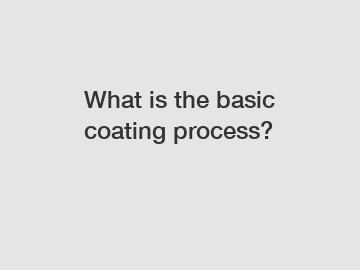What is the basic coating process?
What is the basic coating process?
Coating plays a vital role in numerous industries, from automotive to aerospace, and it is essential to understand the basic coating process. In this article, we will delve into the various aspects of coating, including its types, application methods, and importance across industries. So, let's uncover the fundamentals of the coating process and its significance in enhancing the performance and durability of various products.
First and foremost, what exactly is the coating process? Put simply, coating involves the application of a layer or layers of material onto a substrate, typically to enhance its appearance, protect it from corrosion, increase its durability, or provide specific functionalities. Now, let's discuss the process in more detail by exploring its types and application methods.

Types of Coating:
1. Paint Coating: Paint is probably the most common and widely used form of coating. It consists of pigments, binders, solvents, and additives. Paint coatings are employed in various applications, ranging from household products to architectural structures and automobiles.
2. Powder Coating: Unlike paint coatings, powder coatings are applied in a dry form. They consist of a mixture of finely ground particles of pigment and resin, which are sprayed onto the substrate. The coated product is then heated, allowing the powder to melt and form a smooth, durable, and protective surface.
3. Electroplating: Electroplating involves the deposition of a metallic coating onto a substrate using an electric current. This process is widely used to enhance corrosion resistance, improve conductivity, and provide an appealing aesthetic appearance to various products, including jewelry, automotive parts, and electronic components.
Application Methods:
1. Spray Coating: The most common and straightforward method of applying coatings is through spraying. It involves the use of a spray gun or automated spraying equipment to disperse and evenly distribute the coating material onto the substrate. This method is particularly suitable for large surfaces or products with complex shapes.
2. Dip Coating: Dip coating, as the name suggests, entails immersing the substrate into a tank filled with the coating material. After withdrawal, the excess material is allowed to drip off, and the coating is cured or dried. This method is commonly used for small parts or products that require a consistent and uniform coating.
3. Roll Coating: Roll coating is primarily used in high-speed manufacturing processes. It involves passing the substrate through a pair of rollers, where the coating material is applied to one or both sides of the substrate. This method ensures precise control over coating thickness.
Importance of the Coating Process:
1. Protection: Coatings act as a barrier between the substrate and the external environment, protecting it from corrosion, abrasion, UV radiation, and chemicals. Without adequate protection, materials would deteriorate quickly, leading to increased maintenance costs and reduced lifespan.
2. Aesthetics: Coatings can significantly enhance the appearance of products by providing a smooth, glossy, or matte finish, as per the desired requirements. They allow for color customization and can make products more visually appealing to consumers.
3. Functionality: Coatings can offer specific functionalities to the substrate, such as non-stick properties, conductivity, insulation, anti-reflective capabilities, or self-cleaning properties. These added functionalities widen the range of applications and improve the overall performance of the coated product.
In conclusion, understanding the basic coating process is crucial for various industries seeking to optimize their products' performance, protection, and aesthetics. Whether it's paint, powder, or electroplating coatings, each type and the corresponding application method offers unique advantages and serves specific purposes. Coating not only enhances the appearance and durability of products but also provides added functionalities and protection against external factors. Therefore, it is imperative for manufacturers to carefully consider the coating process when aiming to deliver high-quality and long-lasting products.
Want more information on painted aluminium coil, color aluminum coil factory, hvac coil coating companies? Feel free to contact us.
91
0
0


Comments
All Comments (0)